Rabble Rousers: Frances Goldin and the Fight for Cooper Square co-director and producer Kelly Anderson (Chair of Film & Media Studies at Hunter College) will present her documentary (co-directed with Kathryn Barnier and Ryan Joseph) at the Roosevelt House Public Policy Institute at Hunter College this evening starting at 6:00pm. Following the screening she will be joined by Laura Wolf-Powers (Hunter College Associate Professor of Urban Policy and Planning) for a discussion on the Cooper Square Committee fight against the Robert Moses 1959 New York City “slum clearance plan” that would have levelled their Lower East Side Manhattan neighbourhood displacing the residents (2,400 working class and immigrant families) and small businesses.
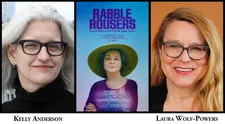 |
| Rabble Rousers co-director Kelly Anderson with Laura Wolf-Powers at the Roosevelt House Public Policy Institute at Hunter College |
From New York City, Kelly Anderson joined me on Zoom for an in-depth conversation on Rabble Rousers: Frances Goldin and the Fight for Cooper Square.
Anne-Katrin Titze: Hello! Quite a day today [E Jean Carroll’s triumph!], wasn’t it?
Kelly Anderson: Yes, yes! Although I was glad to hear, what can I say?
AKT: On to Rabble Rousers. The film is true to all three parts of its title. It’s about Frances Goldin, about the fight for Cooper Square and rabble rousing in general.
KA: We came up with the title at the last minute. For the longest time it was called “It Took 50 Years - Frances Goldin And The Fight For Cooper Square.” We just felt that it was too depressing. This struggle took 50 years, we thought it wouldn’t be appealing for people to want to come to see the movie. And actually there is a bench dedicated to Frances Goldin somewhere in the East Village and on it it says “To a rabble rouser.” That’s how we finally ended up with the title. Fran was truly a rabble rouser. I’m glad we chanced upon that title.
AKT: It fits perfectly. Do you remember the first time you met her?
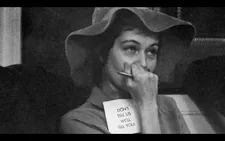 |
| Kelly Anderson on Frances Goldin, food, and dancing: “We felt very strongly that the film should contain these little mini lessons about organising.” |
KA: Well, I didn’t know Fran well. I’ll tell you how this film started. I teach at Hunter and in 2008 I began co-teaching a class at Hunter with a professor in Urban Planning, his name is Tom Angotti. He was in a different film that I made about Brooklyn [My Brooklyn in 2012]. And we decided to try offering a class together that would bring together documentary graduate students from Hunter and Urban Planning students.
They had to make films about neighbourhood issues in New York City. So that film actually was started by two students in that class. And I was involved as a mentor but I didn’t actually become one of the producers or directors until about five or six years ago, because eventually they graduated and tried to turn it into a feature. It was a long process and it was an expensive film and they had no money, because of all that archival material.
So I came on to help them finish the film. I was so committed having made films about urban planning, gentrification, cities, displacement. I felt Cooper Square was such an important story because people are always asking for a success story. And there aren’t very many at all.
AKT: Lincoln Center wasn’t, so many are not. This is the great thing, that it is a success story.
KA: Yes and it’s very hard to find a story where people were able through community organising to actually preserve and protect their neighbourhood. We all worked for free for a really long time to try to get this film to the finish line.
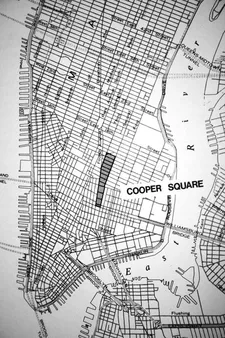 |
| Kelly Anderson on Will Gardiner’s Cooper Square maps: “He was amazing to work with …” |
AKT: You mentioned the archival footage - it’s beautiful and really sets the tone. 1940s Lower East Side, the multicultural community - a bit like Hunter.
KA: Yes!
AKT: Then comes 1959 and Robert Moses with the decision to get rid of it all!
KA: Yeah, that’s one of the things I feel really good about - the way that the film preserves this piece of New York City history. Not only do people not know about it, there’s archival footage in that film that I don’t think people have seen before. Some of it came from the MTA and we had to pay to have it transferred from film because it had not been transferred digitally at all. Some of that footage of Robert Moses projects, that Verrazzano Bridge footage. You do tend to see the same archival footage recycled over and over again in every film.
AKT: Very true.
KA: And I feel that we were able to track down stuff I don’t think people have seen before.
AKT: I also thought the graphics are great because you really understand what is going on. Congratulations on the graphics, not every documentary has that clarity.
KA: Thank you! I have to say Kathryn Barnier, one of the other directors - I had worked with her as an editor, which is how she got involved with these two students. I had recommended her as an editor. She knew Will Gardner who did the maps. Yeah, he was amazing to work with and I remember telling him that we were inspired by the colour and the texture and the fonts that were used on old maps from the Fifties and Sixties.
AKT: Ah, yes, I see.
KA: So he worked with that and I think did a fabulous job. Again, people worked for very little money, so we were borrowing people from all kinds of other projects to do this.
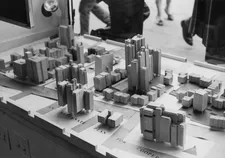 |
| Cooper Square Committee alternative plan maquet |
AKT: Some of the puzzle pieces come together. There is Jane Jacobs - I spoke with Matt Tyrnauer about different films of his and also Citizen Jane. Again there is the community part. They, Jane and Frances, were not rivals in activism, it’s about working together.
KA: Yes, and the number of women involved in all these movements! At one of the screenings somebody asked Tito [Delgado], one of the activists who is in the film, the Puerto Rican guy. Somebody asked him why did Cooper Square succeed? And he said “Because there were all these women.” And it was Jane Jacobs, it was Fran Goldin, it was Jane Benedict, it was a bunch of them, and they really don’t get a lot of credit.
But without them Lower Manhattan really would have been a different place. I do think Jane Jacobs gets a lot of well-deserved credit, but I think there’s room for other people to also come forward in that history as well. I’m glad we got her in there and also that Fran got her due.
AKT: She says at some point “no meeting without food.” And then she quotes Emma Goldman that “If I can’t dance it’s not my revolution.”
KA: I’m proud of the fact that the film doesn’t shy away from Fran’s Communist influences. Because it would have been easy to take that out. At one point there was a discussion that well, maybe her mentioning Lenin, that may be alienating to some. But it was so core to who Fran was and where her values came from that it felt very important to keep that in there.
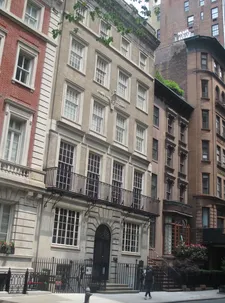 |
| Roosevelt House Public Policy Institute at Hunter College Photo: Anne-Katrin Titze |
The other thing about the food and the dancing, we felt very strongly that the film should contain these little mini lessons about organising. It seems really obvious, but feeding people is really important. A lot of people are coming after work, they had no time to eat, they drop their kids off somewhere or have them in toe - so food is really important. I like that those little pieces are in there.
AKT: Very important, hospitality. It shows respect. I’ll never forget the story about the opposite. Claude Lanzmann describing how he went to Albert Speer’s house for Shoah. He wrote in his memoir [The Patagonian Hare: A Memoir] how during the interview it was turning dark outside - Speer didn’t even turn on the light, offered him no food, no water, nothing. So the Albert Speer school of hospitality is the exact opposite of what we see here.
KA: Right, well, Fran says “I’m a Jewish mother.” Getting back to the whole gender question.
AKT: She has a fascinating biography. There is a photograph where she is posing like Hedy Lamarr. There is the husband, the very personal stories. To include that was an interesting decision. Walter Thabit and his role as a city planner, but also as a person in her life.
KA: I just think it makes the film interesting. People aren’t perfect and our heroes have many aspects to their personalities and Fran knew we were going to tell that story and had talked to Ryan about it. Ryan, the co-director, is the person who worked the most with Fran. When I came onto the film she wasn’t really that well and I didn’t spend much time with her.
Some people asked “Why did you include that? It felt too personal.” But I think it makes the film more interesting and more textured. I find it very moving when Fran says that her relationship with Walter wasn’t perfect. He loved women; she never lived with him until the end. But that his commitment to Cooper Square and his understanding of what makes cities work endeared him to her in a way that she couldn’t let go of.
 |
| Frances Goldin Rabble-Rouser bench in front of St. Mark’s Church on Second Avenue and East 10th Street Photo: Anne-Katrin Titze |
That speaks volumes to me about Fran’s love for Cooper Square and the city and that her love for Walter was really grounded in their mutual love for the same things. I find it moving. I don’t believe the personal and the political can really be separated. It’s a dry story if you don’t include the passion in people’s lives.
AKT: She talks about it, it’s her own words and it does give texture. It fits with the lavender hair and the “Dangerous Grandmother” T-shirt, or something like that, she is wearing. It’s all part of life. I want to talk a little more about the Lower Manhattan Expressway and what was avoided, what could have happened. The city could have had a completely different feel.
KA: Yeah, and finding that Lower Manhattan Expressway film, that was something we got from the MTA archive. When we found it we were like “Wow, we’ve never seen this before!” I guess people know about it from Jane Jacobs, that was her big fight with Robert Moses, to stop that from going through Washington Square Park.
But I don’t know how many people know that it was connected to the urban renewal plan for the Cooper Square area as well. That would have completely destroyed Manhattan, just like it destroyed so many neighbourhoods all around New York City. It’s pretty amazing that this tiny group of activists were able to put a wrench in that.
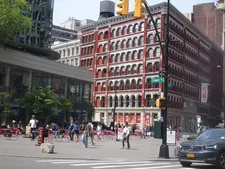 |
| Cooper Square street sign at Astor Place Photo: Anne-Katrin Titze |
AKT: Everything from 9th Street to Delancey was the plan to get rid of? That’s gigantic!
KA: Yeah.
AKT: The checkerboard plan was something I hadn’t heard of and the graphics help very much to understand. Were there moments when you were astonished by these findings?
KA: Well, you know, it’s elegant. It’s so simple in a certain way. Like, we’re going to figure out a way to do this where nobody’s going to have to get displaced. People do this in other places, but in the US I had not heard of a plan like that. Just to explain to people who don’t know, basically there was one empty lot [on Houston Street] that was the basis for their plan.
It was to build housing on that lot, move everybody from the first block of Cooper Square into that housing so they could demolish the block of housing, build new housing and move the people from 2nd Street to 1st Street. The whole plan reflected so much care. The animation there is taken from the original plan. You see they have artist housing, places for schools, it’s very well thought out, it’s not just housing, it’s a whole community. What’s really different about Cooper Square and the community interest there is that they were really committed to keeping everybody there.
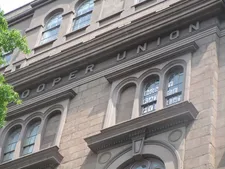 |
| Cooper Union “DON’T RAISE MY RENT” Photo: Anne-Katrin Titze |
A lot of the Community Land Trust movement is about making home ownership more affordable to middle income people and Cooper Square was radical in the sense that it really wanted to protect and preserve the neighbourhood for people who had nothing. They couldn’t buy into middle-income housing. They paid $250 and a monthly maintenance fee. That was the essence of that plan, nobody is going to be displaced and everybody is going to be able to stay, regardless of their income level.
AKT: The care it shows is so much the opposite of the world we live in right now. Just last week I showed my students the clip of Mr. Rogers speaking in front of the Senate about care. Care for people, care for children. I could see in some of their faces, the students were tearing up, and completely not used to this.
KA: Yeah!
AKT: There’s some of that in your film too.
KA: Oh thank you! I love that Mr. Rogers film [Won't You Be My Neighbor? by Morgan Neville]! I cried during that film too. Yes, I think that’s one of the things that documentaries can do in these dark times, is put forward a different set of ethics and values. Especially around home ownership and property, it’s become so common to think of property as a way of building wealth and land as a speculative tool. And to think of housing outside the market and homes as something that have a different kind of value - it is something radical and Cooper Square really did pioneer in that space.
 |
| Rabble Rousers: Frances Goldin And The Fight For Cooper Square poster |
AKT: With this feature I hope that more people will be interested in seeing the film and maybe also come to Roosevelt House on Thursday.
KA: Thank you! We have many RSVPs, so there’s interest in it. So thank you for that.
AKT: In the past years, I’ve been working with Thom Powers on promoting DOC NYC. I did features with some of Hunter’s MFA students who had their short films shown there.
KA: Oh thank you for doing that! It’s really nice that DOC NYC makes the space for students of MFA programmes. And they include the public schools as well, that’s really nice. I’m really appreciative of that, thanks to Thom Powers.
AKT: Thank you, glad we could speak tonight!
KA: Thank you, I really appreciate it!
Rabble Rousers: Frances Goldin And The Fight For Cooper Square will screen on Thursday, May 18 at 6:30pm followed by a Q&A with co-director Ryan Joseph - Barrow Mansion, Jersey City, New Jersey.






















